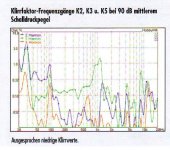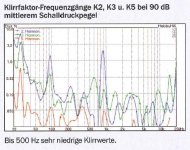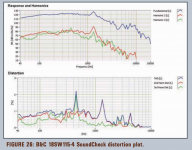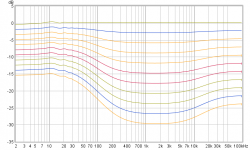BYRTT thanks for those plots... it will be fun to find out what reality brings. As said, my goal is to add headroom and improved left/right balance more than anything else.
As nobody seemed to really look at the reviews i posted about the 30W and 32W, the most striking thing I saw in that review was this;
Distortion levels at 90 dB SPL of the 30W:
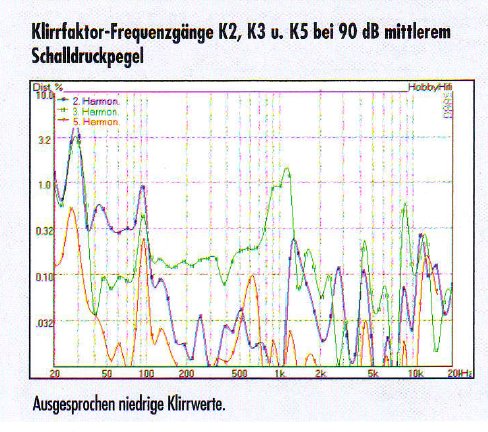
Distortion levels at 90 dB SPL of the 32W:
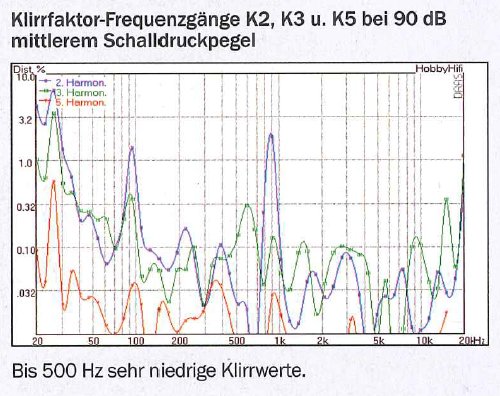
While the 3rd harmonics are cleaned up quite a bit on the 32W (that's what creates that crazy peak at 3 KHz in the FR plots of the 30W) I did not expect the 30W to be this close to it's bigger younger brother. Up til 200 Hz, and enough beyond that to properly roll it of, it looks very usable for my purpose.
P.S. I even liked the waterfall plots and STEP better on the 30W.
As nobody seemed to really look at the reviews i posted about the 30W and 32W, the most striking thing I saw in that review was this;
Distortion levels at 90 dB SPL of the 30W:
Distortion levels at 90 dB SPL of the 32W:
While the 3rd harmonics are cleaned up quite a bit on the 32W (that's what creates that crazy peak at 3 KHz in the FR plots of the 30W) I did not expect the 30W to be this close to it's bigger younger brother. Up til 200 Hz, and enough beyond that to properly roll it of, it looks very usable for my purpose.
P.S. I even liked the waterfall plots and STEP better on the 30W.
Attachments
Last edited:
I'd only bother with lots of separate subs to increase the bass sweet spot, it means more wires to be accommodated
If I were single there's no telling what I would do. I'd probably run stupid large horns (think WE size) with bass arrays and definitely have a multi channel setup too with hardly enough room to sit anywhere. 😛 I'd have a huge screen and a 4K projector on my wishlist.
Ha Ha! I've already bought my 15" Dayton Reference subs, I don't see myself buying more subwoofers in the near future but who knows 😉 I was more trying to point out the klippel measurements in the voicecoil and audioexpress reviews as they seemed to be glossed over in the discussion of the simulated enclosures. They tell you how linear a driver is and how well it will hold up when driven hard. The B&C just so happens to have the best example of what they should look like that I have seen, there would no doubt be others from other manufacturers but klippel measurements are hard to come by.Another question, when are you buying that B&C? Looks like you're in love 😉.
B&C also quotes the Xvar parameter which is interesting to compare across their drivers and consider that in light of other manufacturers xmax figures which can vary from conservative to ridiculous.
This is their explanation
"These limits are customarily indicated by Xmax, the maximum linear excursion. This value is typically measured according to the AES2-1984 standard, corresponding to a maximum of 10% total harmonic distortion (THD) with a sinusoidal signal (though most manufacturers, including B&C, now typically provide data for Linear Mathematical Xmax, not measured Xmax). Recent research shows that this method can yield ambiguous results, and even different numerical values for the same loudspeaker. The main limit of this measurement is that it looks at the output signal instead of the physical features of the driver itself. On the contrary, the most up-to-date instruments for distortion analysis can measure the variations in loudspeaker parameters when they are fed with high-level signals. In this way, an excursion limit can be fixed, beyond which the parameter’s variation becomes excessive.
The “X var” value reported in our data (generally after the traditional “Xmax” value) is measured this way. Beyond this excursion limit, the magnetic field seen by the voice coil, or the total suspension compliance, or both, drops to less than 50% of their small signal value, producing high distortion levels, strong variations from small signal behavior and power compression. The new technique yields different results from the standard measurement based on THD. B&C Speakers believes that this added information gives a more accurate and reliable description on loudspeakers behavior in actual operating conditions."
If he's set on the Paradigm style enclosure I think that is a good driver choice too. I think the Dayton Audio RSS265HO would be worth looking at as they are built to work in very small enclosures. Impedance of the drivers and how they will connected is also a consideration due to using six, if a common amplifier is being used.Haraldo may buy the 6x 32W, wear ear plugs all the time and bring down his house if he wants to, I merely suggested the 26W as a competent alternative that can already do crazy things at budget price compared to the 32W.
No doubt, I don't listen as loud as you do most of the time, I'm interested to find out if adding subs changes that in any way.I do believe I'll be more than fine with just 2x 30W added to my arrays. As BYRTT demonstrated, room gain may add more than enough for a 84-86 dB average playback. I restrict my levels anyway as in the early days of running the array's I could not 'hear' how loud it was. If it's clean, it's very easy to overdo volume levels. I'm known to have long listening sessions, I want to keep my hearing in tact for the years to come.
That was one of the things that struck me about the B&C when I saw the review, less than 1% THD between 40 and 100Hz at 110 to 120dB, and very low 3rd Harmonic. Shame the graph doesn't go below 40 as it seems to be climbing. That's it last comparisonDistortion levels at 90 dB SPL of the 30W:

Attachments
I don't think I'll listen at lower levels when the subs are in. It's the sheer feeling of "being there" that sparked me to listen at about ~86 dB levels on average. It may seem loud to some, but it doesn't feel that way if it's clean and controlled.
As JRiver is used to control that average most all recordings sound pleasant and even low DR recordings will still be played at the same level as high DR ones.
So no sudden louder sounding songs and most material sounds quite good at that level.
The more I was able to improve processing, the more open and "at ease" the sound felt.
Before proper treatment and balance it just sounded wild, though it was highly entertaining for a while, I always grew tired of it.
The music has enough space in it to be comfortable to listen to. At higher levels (compared to lower) it seems you're just rolling your positions up to the front row and make you part of the whole experience, with depth, envelopment and the feeling you can walk trough it. That's what I love about it, it comes so close to being believable.
Like being in the Studio, or at the concert.
I know many strive for party levels but I stick with this fixed boundary, and adjust tonality there. The equal loudness curves would mess up the other listening levels anyway. Fixing the SPL level makes it easier to get satisfying results over a very broad range of recordings without feeling the need to adjust.
I actually never use the arrays for background music.
As JRiver is used to control that average most all recordings sound pleasant and even low DR recordings will still be played at the same level as high DR ones.
So no sudden louder sounding songs and most material sounds quite good at that level.
The more I was able to improve processing, the more open and "at ease" the sound felt.
Before proper treatment and balance it just sounded wild, though it was highly entertaining for a while, I always grew tired of it.
The music has enough space in it to be comfortable to listen to. At higher levels (compared to lower) it seems you're just rolling your positions up to the front row and make you part of the whole experience, with depth, envelopment and the feeling you can walk trough it. That's what I love about it, it comes so close to being believable.
Like being in the Studio, or at the concert.
I know many strive for party levels but I stick with this fixed boundary, and adjust tonality there. The equal loudness curves would mess up the other listening levels anyway. Fixing the SPL level makes it easier to get satisfying results over a very broad range of recordings without feeling the need to adjust.
I actually never use the arrays for background music.
That was one of the things that struck me about the B&C when I saw the review, less than 1% THD between 40 and 100Hz at 110 to 120dB, and very low 3rd Harmonic. Shame the graph doesn't go below 40 as it seems to be climbing. That's it last comparison
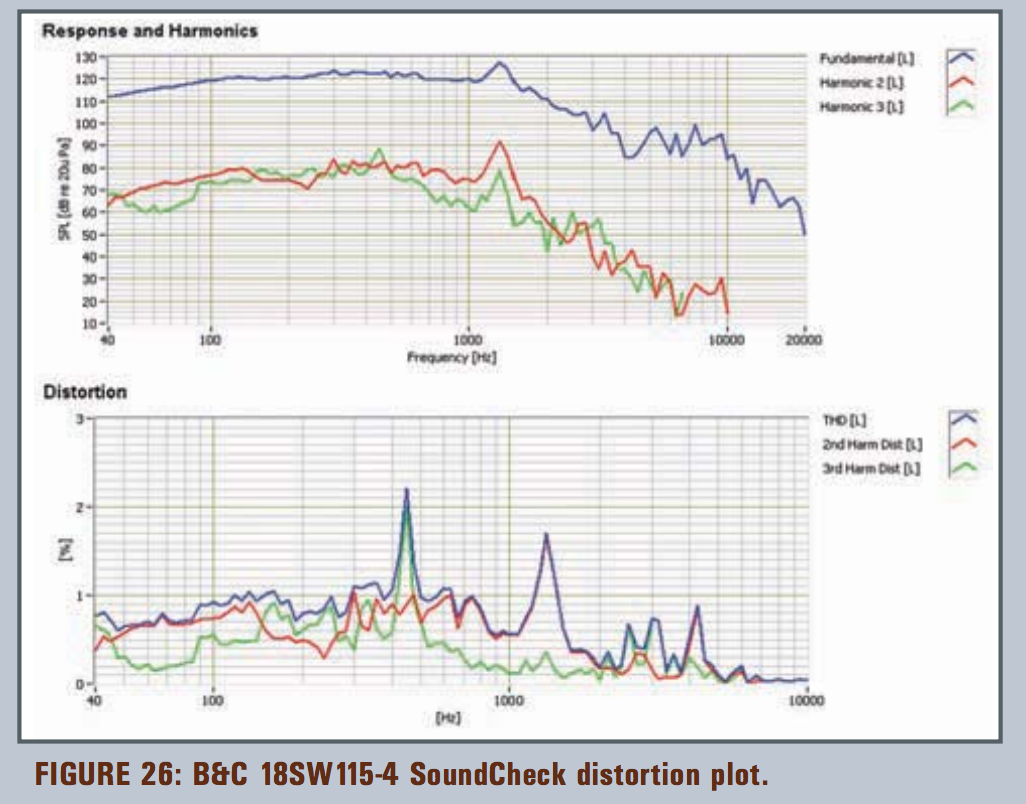
Like I said, you're in love! Just give in to it... 😛
Ok, wait no, yes, I don't need anymore speakers, but I want them....Like I said, you're in love! Just give in to it... 😛

I wanted the 32W, but after looking at the tests I figured why?
We always want more, don't we? Like BYRRT said, for music I already have all I could wish for. Even for movies it would be enough as it is more fun than the local theatres. (we don't have Imax etc. nearby) Well, aside for the screen that's way to small, see? There I go again...
We always want more, don't we? Like BYRRT said, for music I already have all I could wish for. Even for movies it would be enough as it is more fun than the local theatres. (we don't have Imax etc. nearby) Well, aside for the screen that's way to small, see? There I go again...
Last edited:
The 60" LG OLED will fix that problem nicely 🙂Well, aside for the screen that's way to small, see? There I go again...
I'll get what I can get away with... restrictions of being in a relationship/family are healthy.
Makes me work harder to get the best out of what I have. And I kind of love doing that.
Makes me work harder to get the best out of what I have. And I kind of love doing that.
I was just about to ask a question to haraldo,
To me, a sub like the Paradigm (except for bragging rights) only makes sense if you plan to use it somewhat free-standing.
I'd rather have the same amount of drivers in separate enclosures (or a line) to be able to play with placement separately.
I agree that the sub used probably isn't like the Scan Speaks, I just mentioned the 26W as the 32W got so much attention from haraldo. The 26W and 30W share a similar pedigree of the 32W. Not saying they are the same, but just look at cone size and their weight shows they are alike.
If the Paradigm uses roughly 216 litre...
Sticking the 26W in a 25 litre box per driver would get you a Q of 0,703.
I don't think that's such a bad starting point for DSP. 6 x 25L = 150L
Leaving enough space for driver volume, electronics and bracing.
A total cone area of 2112 cm² from these 6 drivers, in comparison the B&C SW115-4 has 1210 cm².
Don't underestimate multiples 🙂. That's why I figure it would be a feasible option.
The Scan Speak has 12.5 mm x-max, the B&C 14 mm, which one will move more air (or need less cone movement)?
(quick figures in WinISD for 6 drivers is 105 dB at 20 Hz max, before room gain for 6x 26W, I think in room would
see more than that. I did say you'd probably go deaf before hearing the limits)
The 32w would have 3156 cm² of cone area and either 14 mm (heavy cone) or 7 mm (light cone) of x-max.
All in all I think that even the 26W, used like that would be "impressive".
So I spent all this time auditioning all kinds of different configurations and setup's including a whole range of different line source" bass towers. The "Adyton" and "Audio Insight" bass towers are really popular around here and work exceedinly well, but are waaaaaaay pricy!!!!
the downside is that it simply just gets too physically intrusive and for me personally it's just not something I imagine I could put into the space I have. Limitations with the living room and I would possibly not be able to look outside the windows.
This one is based on what looks like the Seas 8" prestige woofers, incredibly dynamic, supertight bass and there seem to be no compression at any kind of level.... but there is soomething about the size of such a setup.... this type of linesource seem to be immune to room nulls, I simply cannot hear any room issues with this kind of setup
Mulitple subs around the room, I simply cannot fit due to space setup and constraints...
On the other side I auditioned systems with products like the Burmester S8 subwoofer which has two 12" drivers back to back, and understanding whatever works better or worse is hard....
However, by far and without any doubt the best bass I ever head was with a system comprising of a set of Audio Physic Avanti III and with 4 corner placed Audio Physic Minos subwoofers.... no-one above, no-one besides....
The Minos uses what looks like pretty regular 12" woofers, like of Peerless making .... nothing very extreme.
The claim inside here that I just copy paradigm and hope for the best I take as a direct insult.... it may be the other way around.... ages ago I wrote a post on the benefits of hexagon cabinets, maybe those guys read my post before making those subs 😛
I think hexagons has some benefits....
+ Over million of years, nature selected the shape as the nest and most rigid shape for a given volume, at least bees seem to think so
+ There is less surface area for a given volume, giving less audible cabinet reflections, I believe
+ The baffle cutouts are smaller, so you'd get the panel vibrations at a higher frequency, effectively leaving them outside the passband,
of course you do a lot of bracing but it will never be 100% efficient I guess?
guess you can make cabinet even tougher and stronger
+ Box will be extremely rigid and tough
- The boxes will be bears to manage and impossible to deal with alone
- More issues with standing waves and room nulls
What I am looking for is just something to play music very well, without compromise and any dynamic limitations, whatever is being fed in there 😛
Space and size constraints imply that I probably need to go "compact"
Last edited:
I don't think I'll listen at lower levels when the subs are in. It's the sheer feeling of "being there" that sparked me to listen at about ~86 dB levels on average. It may seem loud to some, but it doesn't feel that way if it's clean and controlled.
As JRiver is used to control that average most all recordings sound pleasant and even low DR recordings will still be played at the same level as high DR ones.
So no sudden louder sounding songs and most material sounds quite good at that level.
The more I was able to improve processing, the more open and "at ease" the sound felt.
Before proper treatment and balance it just sounded wild, though it was highly entertaining for a while, I always grew tired of it.
The music has enough space in it to be comfortable to listen to. At higher levels (compared to lower) it seems you're just rolling your positions up to the front row and make you part of the whole experience, with depth, envelopment and the feeling you can walk trough it. That's what I love about it, it comes so close to being believable.
Like being in the Studio, or at the concert.
I know many strive for party levels but I stick with this fixed boundary, and adjust tonality there. The equal loudness curves would mess up the other listening levels anyway. Fixing the SPL level makes it easier to get satisfying results over a very broad range of recordings without feeling the need to adjust.
I actually never use the arrays for background music.
To improve enjoyment for background music levels have you ever try turn on the equal loudness curve in JRiver and calibrated it, works fantastic for lower lewels if you ask me 🙂 below is 96kHz loopback of Jriver when loudness is turned on lowering volume in steps of -3dB so that upper curve is about 86dB at listening position and lower curve is -30dB below that.
Attachments
Well, to get good bass requires a good look at the room. Even though we have looked at the linearity of subs in these recent pages, for me: all things audio is how well you can get it to go together inside your own room.
It is there where DIY kan make the big difference. We can build something that fits our aesthetic needs and works well inside our room. Plan the room, even more than planning which drivers to use. As that space is what has an enormous influence on what we get to hear.
That's how I ended up with arrays as my personal compromise. Bass towers are out for me. It is not going to happen. But I don't need them, one can debate if I actually need subs, not for music anyway.
Look at what you can get away with, to make it gel with the room. You probably have strong solid walls, which goes well with room gain. You might not need monster solutions at all.
If my room were bigger, no way these arrays could have been satisfying at all for the spectrum I want out of it. This is why I think adding two 12" subs will be more than enough in my case. I know koldby has a much larger space than I have, for him bass towers are going to make a lot of sense.
It isn't about the best subwoofer(s) at all, it is how well you can make it play inside your own space that counts.
I like that Paradigm sub, but I couldn't use it in my house. I like that Magico QSub-18 too (lol). But that would never be a solution in my home.
It is there where DIY kan make the big difference. We can build something that fits our aesthetic needs and works well inside our room. Plan the room, even more than planning which drivers to use. As that space is what has an enormous influence on what we get to hear.
That's how I ended up with arrays as my personal compromise. Bass towers are out for me. It is not going to happen. But I don't need them, one can debate if I actually need subs, not for music anyway.
Look at what you can get away with, to make it gel with the room. You probably have strong solid walls, which goes well with room gain. You might not need monster solutions at all.
If my room were bigger, no way these arrays could have been satisfying at all for the spectrum I want out of it. This is why I think adding two 12" subs will be more than enough in my case. I know koldby has a much larger space than I have, for him bass towers are going to make a lot of sense.
It isn't about the best subwoofer(s) at all, it is how well you can make it play inside your own space that counts.
I like that Paradigm sub, but I couldn't use it in my house. I like that Magico QSub-18 too (lol). But that would never be a solution in my home.
To improve enjoyment for background music levels have you ever try turn on the equal loudness curve in JRiver and calibrated it, works fantastic for lower levels if you ask me 🙂 below is 96kHz loopback of Jriver when loudness is turned on lowering volume in steps of -3dB so that upper curve is about 86dB at listening position and lower curve is -30dB below that.
Yes I have used that and it does work. However even at lower volumes the arrays attract a lot of attention to themselves, are distracting as a mere fill in, hard to explain. It's like having a band play continuously at low levels, you keep focussing on that. They pull the attention away from whatever you're doing, be it a conversation etc.
It still fills the room with sound, would work quite nice for a party but not for every day radio listening. Our Sonos does that job way better. Even in mono.
Whenever I want to engulf myself in Audio I turn on the towers. They usually play a lot around x-mas when the yearly top 2000 is aired.
I was disappointed at first, figured I needed to work on that and tried the dynamic loudness feature. For being alone at home, it would work well enough for me. But it is as distracting as a couple of kids having a conversation at the diner table while you want to concentrate on work and type up a report. The mono Sonos does not have that effect on me. I hear it, am aware of it but can filter it out when needed. It never bothers me or distracts me.
If I really start to listen to the Sonos, lots of things fall apart and I would grab my measurement gear (lol).
Last edited:
My experience is similar to yours. I can't do serious work in the same room with my music; its too distracting. Strangely though, (in my previous house) I enjoyed having it on and hearing it in the background when I was working in the next room, my office.
I have been after the best Stereo replay I could get. I never figured that would stand in the way of background listening.
Maybe I should consider playing one array in mono for background. I can see that working real well!
Maybe I should consider playing one array in mono for background. I can see that working real well!
... However even at lower volumes the arrays attract a lot of attention to themselves, are distracting as a mere fill in, hard to explain. It's like having a band play continuously at low levels, you keep focussing on that. They pull the attention away from whatever you're doing, be it a conversation etc....
I can imagine that, after listening to your arrays.
Until now it has prevented me from building arrays, also because my listening room is also my working space.
With my current loudspeakers (very satisfied with my 30W subwoofers by the way...) I can listen while working and the other way around. Also plenty good enough for my TV sound.
When the music asks for I quit working and focus on the music.
Maybe line arrays are somewhere between headphones and point source loudspeakers.
I decided to build a high quality headphone system (have AKG K1000's waiting) for the ultimate (and highly individual) listening experience.
I expect to be satisfied with the 30W too, especially with the combination of the 500 watt Hypex feeding it 😉.
Off to the garage to line the inner walls with mass loaded vinyl. Gluing it with a neoprene based glue.
Off to the garage to line the inner walls with mass loaded vinyl. Gluing it with a neoprene based glue.
You are going to be just fine, and that's an understatement.
I'm looking forward to reading your first listening experience.
What kind of music are you into?
I'm looking forward to reading your first listening experience.
What kind of music are you into?
- Home
- Loudspeakers
- Full Range
- The making of: The Two Towers (a 25 driver Full Range line array)
